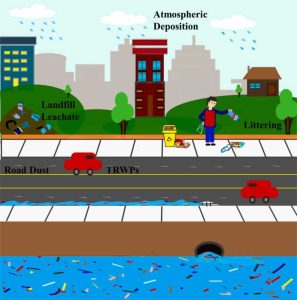Plastics are a persistent pollutant. Their synthetic nature means that they are not biodegradable and 100 years after their invention, they now pollute most environmental niches across the globe – from the top of Mount Everest to the bottom of the sea.
Without biodegradation, most plastics in the environment breakdown into smaller and smaller pieces of plastic waste over time. The pollution pathway is driven by weathering (heat and mechanical stress). Once the particles are less than 5mm, they become what is commonly called microplastics.
Microplastics are washed into stormwater from across the catchment, with more than 80% originating from terrestrial sources such as tyre abrasion, road dust, litter, landfill and soils (Koutnik et al. 2022; Shafi et al. 2024). Their transportation into stormwater depends on land use, rainfall intensity, microplastic particle size and density and drainage characteristics. Stormwater can, however, act as a significant conduit for microplastics from terrestrial to aquatic ecosystems and waterways (Figure 1 – Shafi et. al. 2024). Based on their review, Shafi et. al. (2024) concluded that stormwater contributions to microplastic pollution of receiving waters is significantly greater than that of wastewater treatment plant effluent.

Figure 1
Concentrations of microplastics can vary widely depending on local pollution sources with a range of 0.38 to 197,000 particles per litre reported across the globe (Shefi et. al. 2024). Concentrations of microplastics in stormwater (from 0 to 3500 particles per kilogram of dry sediment) were found to be lower in catchments with less intensive urbanisation in a recent study of five Western Australian stormwater drainage systems (Lutz, Fogarty and Rate, 2021). Sediment grain size was also a significant predictor for microplastic abundance, with sandier sediments accumulating more microplastics. Bond, Li and Rate (2022) also studied microplastics in six urban catchments in Perth, Western Australia, and found that there was little variation in microplastic concentrations both across and within catchments, suggesting that microplastics are ubiquitous in urban stormwater in that region. Given their persistence in the environment, we can probably safely assume that most urbanised catchments contain enough microplastics to be problematic for people and biota.
Water sensitive urban design (WSUD) elements, such as biofilters and constructed wetlands, are designed to intercept particles and will therefore accumulate microplastics from incoming stormwater. They may also receive microplastics via atmospheric deposition. Studies of stormwater control measures (SCM) in Los Angles, USA, found that stormwater was not the only input to SCM (Koutnik et. al. 2022). Outside the SCM, subsurface retardation coefficients changed with soil particle size, indicating that physical filtering was the dominant removal mechanism. Within the SCM, retardation was not correlated with particle size, suggesting that microplastics were moving deeper into the soil profile, or they were imported with materials used during SCM construction or maintenance (e.g. soil, mulch, compost). The relative importance of stormwater and atmospheric deposition as sources of microplastics will be dependent on the catchment water quality and air quality. Stormwater inputs are, however, likely to be episodic, whereas atmospheric deposition is continuous and could result in high net loading without being apparent to WSUD asset managers.
The risks associated with microplastic pollution are relative to the total amount of microplastics accumulated in the WSUD element, the proportion that are mobile and the load to receiving water bodies. Wise management will require a greater understanding of local pollutants sources and impact pathways. Mitigation is likely to require a catchment-wide approach across plastic product life-cycles. Installing chains of WSUD that are well-designed and maintained are a critical part of the solution as well as stopping plastic pollution at its terrestrial sources.

Bond C, Li H and Rate A (2022) Land use pattern affects microplastic concentrations in stormater drains in urban catchment in Perth, Western Australia. Land 2022.
Koutnik V, Leonard J, Glasman J, Brar J, Ceylan Koydemir H, Novoselov A, Bertel R, Tseng D, Ozcan A, Ravi S and Mohanty S (2022) Microplastics retained in stormwater control measures: Where do they come from and where do they go? Water Research, Vol. 210.
Lutz N, Fogarty J and Rate, A (2021) Accumulation and potential for transport of microplastics in stormwater drains into marine environments, Perth region, Western Australia. Marine Pollution Bulletin. Vol. 168.
Shafi M, Lodh A, Khajuria M, Ranjan V, Gani K, Chowdhury S, Goel S (2024) Are we underestimating stormwater? Stormwater as a significant source of microplastics in surface waters. Journal of Hazardous Materials. Vol. 465.





